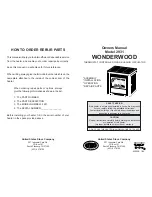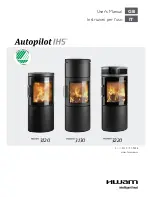
March 19, 2003 11
250-6422
Castile Pellet Stove
R
CLEANING AND MAINTENANCE
3. DISPOSAL OF ASHES
a. Ashes should be placed in a metal container with
a tight fitting lid. The closed container of ashes
should be placed on a noncombustible floor or on
the ground, well away from all combustible materials,
pending final disposal. If the ashes are disposed of
by burial in soil or otherwise locally dispersed, they
should be retained in the closed container until all
cinders have been thoroughly cooled.
4. HEAT EXCHANGER MAINTENANCE AND
CLEANING
a. This stove has two heat exchange chambers. Each
chamber is equipped with its own cleaning rod. To
access the cleaning rods, open the cast hinged
face. Both pull rods are located next to the face of
the stove. To clean, gently pull the rod straight out
approximately 5-1/2" (140mm). Slowly move the
rod in and out a couple of times.
b.
HOW OFTEN SHOULD YOU CLEAN THE
HEAT EXCHANGER?
The amount of ash buildup in the firepot will be
a good guide to determine how often you should
clean the Heat Exchangers. Typically you should
clean the Heat Exchangers at least once a week.
This will keep your stove running at peak efficiency.
Also, after burning approximately one ton of fuel,
the ash will need to be removed from beneath the
Heat Exchangers.
c.
Remove Top Baffle.
There is a latch to keep the
Top Baffle from coming out when cleaning the Heat
Exchangers. Push the latch up with your finger
while sliding the Top Baffle toward you, it will then
drop out. (Refer to Top Baffle Removal Instructions,
page 17, Figure 17A and 17B). Remove both cast
firebrick panels. At the top of each panel is a tab.
First lift, then pull outward. With baffle and panels
removed from stove a thorough cleaning can now
be performed. Pull the Heat Exchanger cleaning
rods OUT and IN to clean the uppermost portion
of the Heat Exchanger Tubes. This area is only
accessible when the baffle is removed from the
stove. Reinstall panels and baffle and latch when
finished cleaning.
NOTE: Unplug the stove before performing any
cleaning or maintenance.
1. FIREPOT
a. It takes very little time to clean the firepot. We
recommend that you clean the firepot daily. However,
if the fuel you are burning has a high dirt content or
you are burning shelled field corn, it will be necessary
to clean the firepot more often. Dirty fuel will cause
clinkers to form in the firepot. A clinker is formed
when dirt or a nonburnable substance is heated to
2000
°
F
(1093
°
C) and becomes glass-like.
b.
To clean the firepot
:
1. Wait for stove to be in complete shutdown
(Exhaust Blower off).
2. Pull Firepot Cleaning Rod out, then push back into
the closed position. This can be done a couple
times to help shake debris loose. Be certain plate
is fully closed when finished.
3. Periodically the ash pan will need to be emptied.
It is located underneath the firepot. To remove
it open the bottom ash door and slide the ash
pan straight out. Empty into a non-combustible
container and reinstall ash pan.
NOTE: NEVER pull rod when stove is operating.
2. FIREBOX ASH REMOVAL
a. Clean as needed due to ash buildup.
b. Allow stove to cool completely.
c. Ensure there are no hot ashes in the firebox prior
to cleaning.
d. With the cast hinged face open, look directly
underneath the firebox door. To the left and right
of the firepot are two cleaning slides. Pull both
slides out and open the glass door. Now sweep the
remaining ash from the firebox into the two open
holes. This ash will end up in the same ash pan as
the firepot debris. The ash pan should be emptied
every time you clean the firebox. Remember to place
the ash and debris into a metal or noncombustible
container. Be sure the two cleaning slides are fully
closed when finished cleaning the firebox.
NOTE: Embers remain hot for many days. Store
container in a safe place away from combustibles.










































